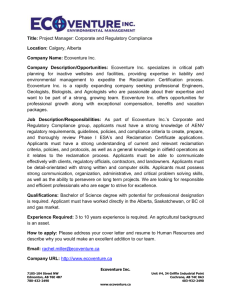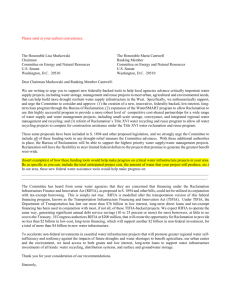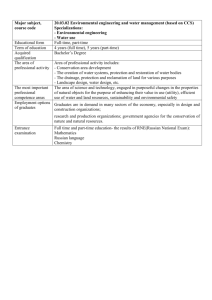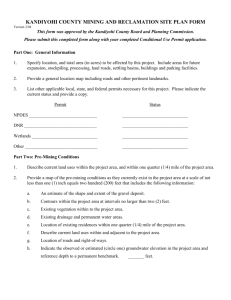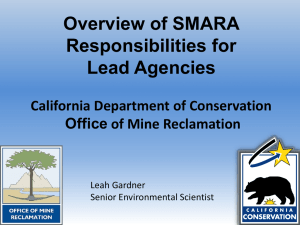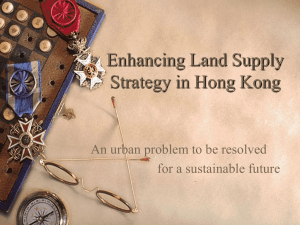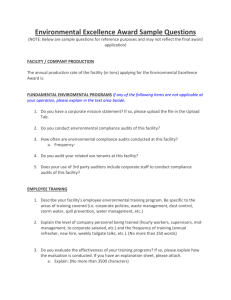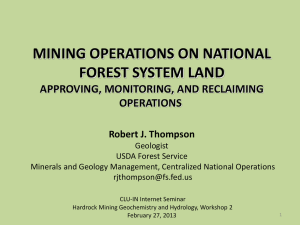Conservation and Reclamation Business Plan (CRBP)
advertisement
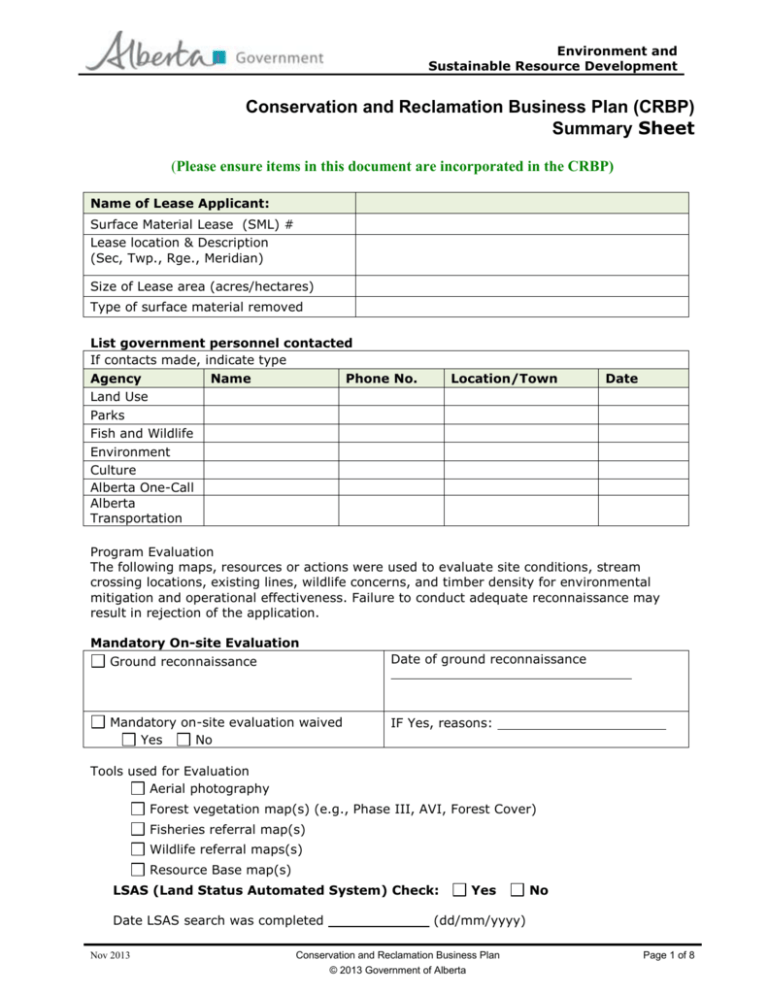
Environment and Sustainable Resource Development Conservation and Reclamation Business Plan (CRBP) Summary Sheet (Please ensure items in this document are incorporated in the CRBP) Name of Lease Applicant: Surface Material Lease (SML) # Lease location & Description (Sec, Twp., Rge., Meridian) Size of Lease area (acres/hectares) Type of surface material removed List government personnel contacted If contacts made, indicate type Agency Name Phone No. Land Use Parks Fish and Wildlife Environment Culture Alberta One-Call Alberta Transportation Location/Town Date Program Evaluation The following maps, resources or actions were used to evaluate site conditions, stream crossing locations, existing lines, wildlife concerns, and timber density for environmental mitigation and operational effectiveness. Failure to conduct adequate reconnaissance may result in rejection of the application. Mandatory On-site Evaluation Ground reconnaissance Date of ground reconnaissance Mandatory on-site evaluation waived Yes No IF Yes, reasons: Tools used for Evaluation Aerial photography Forest vegetation map(s) (e.g., Phase III, AVI, Forest Cover) Fisheries referral map(s) Wildlife referral maps(s) Resource Base map(s) LSAS (Land Status Automated System) Check: Date LSAS search was completed Nov 2013 Yes No (dd/mm/yyyy) Conservation and Reclamation Business Plan © 2013 Government of Alberta Page 1 of 8 Conservation and Reclamation Business Plan (CRBP) Summary Sheet A complete check must be made on the proposed lease area to determine industrial holdings and/or dispositions, agricultural dispositions, Indian Reserves, Metis Settlements, traplines, FMA’s, etc., along with other areas of special concern. In addition, use LSAS to identify any reservations placed on lands: Protective Notations (PNT), Disposition Reservations (DRS), etc. Where reservations exist, list and explain how they will or why they will not affect the program, and any actions that are required. Identify Reservations needing mitigation and the actions required (e.g., PNT, CNT) Identify Areas of Special Concern Indicate if any part of the proposed lease falls in the following area(s). If yes, it is recommended that you contact the appropriate agency for additional information (see previous Contact Identification list) Caribou Area: Yes No If Yes, provide Caribou Protection Plan Number: Critical Wildlife Areas Integrated Resource Plan (IRP): Yes No Ungulate Winter Range: Yes No If yes, timing restrictions apply. Check applicable box below: Boreal – Jan.15 to April 30 (where applicable Southern- Jan. 1 to April 30 If Yes, indicate plan name and list the parameters applicable to surface mining activities, which apply to this program. Name of IRP: Southwest Corner Mountain South of Kananakis Country Dec.1 to April 30 Applicable Parameters: Foothills south of Kananaskis Country Dec. 15 to April 30 Other Critical Wildlife Areas: Identify: Do timing restrictions apply: IF Yes, specify dates: Yes Yes No No List any other requirements/conditions to be applied: Parks and Protected Area (e.g. Wildland Park, Recreation Area, etc.) Natural Area/Eco-reserve/Heritage Rangeland: Yes No Is the proposed lease within or adjacent (within 100m) of a protected area? Yes No If Yes, indicate name of area and list any terms or conditions stipulated in the Management Plan or as directed by the regulating agency. If Yes, indicate the name of the park or protected area, and list any terms or conditions stipulated in the Management Plan or as directed by Parks and Protected Area staff. Name: Name: Terms/ Conditions: Terms/conditions: May 2014 Conservation and Reclamation Business Plan © 2014 Government of Alberta Page 2 of 8 Conservation and Reclamation Business Plan (CRBP) Summary Sheet Are Permanent/Research Sample Plots/Rangeland Benchmarks located within 100 m of the boundary of the lands under application? Yes No If ‘Yes’, indicate the legal land description and GPS coordinates for each plot/benchmark in relation to the disposition boundary (degree, decimal, minutes). Reservation No. PSP/RSP No. LSD Sec Twp Rge W Latitude Longitude Distance away First Nations Consultations: (Contact Field Office to determine if consultation is required) Required Not required If required, with whom If applicable, describe any proposed mitigation plans developed with directly impacted stakeholder (e.g., residences along haul routes). FireSmart Community Zone Within a FireSmart Community Zone? Yes No If ‘Yes’, contact Forest Protection Division for additional hazard reduction requirements. Alberta SRD - Wildfires - FireSmart - Information & Projects Testing Information Testing must be carried out to determine the general extent of the potential deposits of sand and gravel. Describe the following in the CRBP: Detailed testing: Describe the method of testing used: Backhoe one photograph for every fifth test hole included in report (required) Auger drill Hammer drill Geophysical survey (e.g. ground penetrating radar, electromagnetic survey) Verified using appropriate number of test holes to depth Geological interpretation (i.e. river bank, adjoining pit, surficial features). Other Test hole locations numbered and labeled with GPS coordinates on operation sketch? Complete Test hole information provides a representative sample of the extent of the deposit. Are there proficient number of test holes to characterize the extent of the deposit for the proposed area: Yes No If No, Why Test logs illustrating profile of each hole attached: Depth of Deposit Total Volume of deposit estimated in the Licence Intended Depth of Excavation May 2014 Complete m m3 m Conservation and Reclamation Business Plan © 2014 Government of Alberta Page 3 of 8 Conservation and Reclamation Business Plan (CRBP) Summary Sheet Environmental & Ecological Factors Site-specific environmental data (baseline data) must be collected. This information allows the operator and the Land Manager to understand the potential impacts of these operations, and to develop mitigation strategies as part of the Conservation and Reclamation Plan. Environmental baseline data is to be identified and/or mapped on the proposed lease area, including all adjacent interests (e.g., highway, pipeline right of way, water well), and adjacent environmental considerations (e.g., water body or topography anomaly). The following baseline information is required to determine probable environmental impacts. Assessing this information will identify many impacts associated with the activity. This will allow the operator to determine what measures and methods will be used to mitigate the probable environmental impacts. Describe and delineate the following: Describe the species composition: Vegetation and Timber Cover Vegetation (describe what type applies) Native grassland Treed wetland Tame pasture Shrubby wetland Cropland Grass or grass-like wetland Sparsely or non-vegetated Native aspen parkland Cutblock – planted Other (specify) Natural regeneration >2 m Deciduous-dominant forest: (“D” less than 30% coniferous trees) Coniferous-dominant forest: (“C” more than 70% coniferous trees) Mixedwood forest: (“CD” 70% to 50% coniferous trees) (“DC” 50% to 30% coniferous trees) Timber Salvage 1. Merchantable timber present? Yes No Provide a volume inventory as follows: Coniferous approx. volume mз or number of loads Spruce % Pine % Other % Deciduous approx. volume mз or number of loads Aspen % Other % 2. Specify the timber disposition or FMA(s) shown on LSAS. No disposition (Contact SRD field office) Disposition number of FMA: , holder name Soils Profiles (depth of each horizon). Determine the average depth of topsoil, subsoil and overburden. Initial restrictions should be investigated, such as, water permeability, vertical root elongation, and soil compaction. What is the dominant soil classification for the area? What is the dominant soil texture for the topsoil, subsoil, and overburden layers Note: Soil data is required to assist in evaluating the reclamation potential of the area All surface soils must be salvaged and replaced on the site. Preplanning ensures the integrity of the salvaged topsoil for future reclamation. Dominant Soil Profile and texture A horizon Texture Depth B horizon Texture Depth Overburden Depth m May 2014 Conservation and Reclamation Business Plan © 2014 Government of Alberta m (Topsoil) m (Subsoil) Page 4 of 8 Conservation and Reclamation Business Plan (CRBP) Summary Sheet Fish and Wildlife Presence of Weeds List types (species) and any critical habitat features (e.g. migration routes) must be described. Critical wildlife zones and timing restraints must be identified. (refer to wildlife habitat map) The presence of noxious/restricted nuisance weeds has been detected on site? Yes No If yes, describe species. Topography Describe topographic features and slope percent of the site using the Canadian Land Inventory Index (CLI) classes. Indicate the slope class of the site land based on Canada Land Inventory (CLI) slope classes. level 0 - 0.5% (200:1) nearly level 0.5 - 2.5% (50:1) very gentle slopes 3.5 - 5% (20:1) gentle slopes 6 - 9% (10:1) moderate slopes 10 - 15% (6:1) strong slopes 16 - 30% (3:1) very strong slopes 31 - 45% (2:1) Describe areas where the operations may affect slope stability. Provide information on the prevailing type of topography. Surface expression is the form (grouping of slopes) and patterns of the land. Identify the surface expression(s) of the site and access. Is it inclined, undulating, rolling, ridged, hummocky, steep, terraced, an apron, fan, blanket, veneer, etc.? Erosion - Man Made - Naturally Occurring Identify any evidence of erosion. Hydrography Map surface drainage patterns on a watershed basin or sub-basin level (Provide a contour map of the area with site boundaries plotted or show the drainage pattern on a site plan) Indicate if the site contains or is adjacent to a: ephemeral draw [vegetative draw, no channel development] intermittent waterbody [bed & shore development – width varies] small permanent waterbody [bed & shore development - up to 5 m in width] large permanent waterbody [bed & shore development – width greater than 5 m] Yes No If applicable, has a qualified professional assessed the site for operational design requirements. Note: Operations that may cause “harmful alteration, disruption or destruction of fish habitat”(HADD) will require authorization under the Federal Fisheries Act. Site Drainage Describe the site drainage (i.e., drainage is very poor, poor, imperfect, moderately well, well, rapid, or very rapid.) Hydrogeology Provide summary of the location and depth of groundwater encountered Was water encountered in ___ of ____ holes? Yes May 2014 Conservation and Reclamation Business Plan © 2014 Government of Alberta No Page 5 of 8 Conservation and Reclamation Business Plan (CRBP) Summary Sheet Has the water table depth been established. (average depth) (refer to cross-sections) Yes No @ ___ m Will the operation extend below the water table? Yes No Will Pit de-watering likely occur? Yes No If Yes, show on the operation plan the points of diversion and discharge. If surface/groundwater is being used, diverted an approval under the Water Act may be required. Historical Resources Historical Resource Value Not Listed 1 4 2 5 3 Species at Risk (plant/animals) Is it likely that a species at risk will be found in the area of the proposed development? Yes No Review the potential for historical, palaeontological, or archaeological resources. Check the current Listing of Historical Sites and Areas Document to determine if the proposed activity occurs on lands ranked with a Historical Resource Value. Check the appropriate box to the left. (www.cd.gov.ab.ca). Note: If HRV is 1-5 an “ Application for Historical Resources Act Clearance” must be submitted to the Cultural Facilities and Historical Resource Division (CFHRD). Activities on land that have a HRV of 4 or 5 may require a Historical Resource Impact Assessment (HRIA). Species at Risk are species: Listed as Endangered or Threatened un the Alberta Wildlife Act Designated as Special Concern in Alberta Listed as Endangered, Threatened or Special concern in Alberta by COSEWIC; and/or the Species at Risk Act If Yes: Specify for each species, the status and protective strategy i.e. Species at Risk (Plants/Animals)_ Endangered At risk Threatened May be at risk Special concern Sensitive Has an Alberta Natural Heritage Information Center Database (ANHIC) search been completed? Date Explain any conflicts and proposed mitigations within the report Existing Land Use List all land uses, including recreational use, that occur within and adjacent to site and all activities that may be affected. Describe the mitigation techniques that will be used. Existing Disturbances Identify and list all disturbances or man-made alterations on the site (must be illustrated on operation plan). Other Interest Holders Identify and list all on-site and adjacent interests to ensure all prior land uses have been considered in the proposed development (must be illustrated on operations plan). If necessary, consultation is conducted at this stage. All protective measures and agreements for adjacent lands are to be in place and identified. May 2014 Conservation and Reclamation Business Plan © 2014 Government of Alberta Page 6 of 8 Conservation and Reclamation Business Plan (CRBP) Summary Sheet Resource Extraction Activities How will the proposed lease be accessed? Access Access Management: If applicable, describe how operations will be coordinated with other resource industries (e.g., Forest Management Agreement holder, oil and gas industry) to reduce footprint Identify and Illustrate (on operation sketch) existing or new access to the proposed lease. Security Deposit Assessment Phase one of the operation is ha Identify all surface area that has been disturbed and will be disturbed by development. This includes roads, stockpiles sites, pit development, site clearing within the lease area. This area is used to calculate the security deposit. The initial security deposit will be based on the first phase of development. Erosion Prevention Techniques Describe all measures that will be taken to mitigate potential wind and water erosion during operations. Mitigation of Environmental Effects Identify all environmental impacts and describe the proposed measures that will be taken to mitigate any negative impacts. This includes, but not limited to, impacts on vegetation, fish and wildlife species (populations and habitat). Buffer Zones Are there any buffers required for this proposed lease: Yes No If Yes, illustrate on the operation sketch the location and width of each buffer. Water Control Show on the operations plan the locations of all proposed drainage ditches (note: engineering plans for the necessary approvals under the Water Act can be included) Weed Control Explain how monitoring and control of weeds will be implemented during the operation and during reclamation. Associated Activities Indicate any activities associated with aggregate processing that will take place on site, such as asphalt plants, crushing, screening, sand and gravel washing. Show the locations of the activities and describe pollution control measures that will be used for such activities. List all approvals needed for these activities. May 2014 Conservation and Reclamation Business Plan © 2014 Government of Alberta Page 7 of 8 Conservation and Reclamation Business Plan (CRBP) Summary Sheet Reclamation As part of the requirements, a Progressive Reclamation plan must be developed showing that reclamation will occur during the entire life of the operation, in a manner that is concurrent with the sequences established for extraction. The area of excavation, as agreed to in the CRBP illustrated through phasing sequence, must begin reclamation before entering the next phase of extraction. The size of the maximum cleared area will depend on site-specific parameters. Through discussions with the appropriate resource managers, the operator is to identify the size of each phase and include it in the plan. Minimum Content of Reclamation Plan Requirements Proposed End Land Use The end land use should be compatible with adjacent lands. What is the best end land use for the specified site? What will the site be reclaimed to? Will a waterbody be created after reclamation? If a waterbody is created, what is the size and location (illustrate on reclaimed site plan). Reclaimed Topography Provide the anticipated final reclamation grade (illustrate on reclaimed cross-sections). Describe how the overburden, subsoil, and topsoil will be replaced. Topsoil Average depth of replaced topsoil: m Subsoil Average depth of replaced subsoil: m Overburden Average depth of replaced overburden Revegetation Describe the revegetation strategy and if necessary state which approved seed mixture, will be used. (Note: the type of seed mixture should be compatible with soil type and surrounding vegetation). m What process of weed and erosion control management will be implemented? Native Plant Revegetation Guidelines for Alberta Revegetation Strategy was developed in consultation with Departmental officer. Yes No All illustrated plans (site plan, development plan, and cross-sections) must meet the information requirements found on page 18 of the guide. May 2014 Conservation and Reclamation Business Plan © 2014 Government of Alberta Page 8 of 8
